Toggle Nav
Search
With years of performance piston experience, JE knows ring operation is just as important as piston quality. Follow along with our complete, step-by-step guide to installing rings on your motorcycle or ATV piston(s).
The correct installation of the piston rings is an essential aspect of rebuilding any four-stroke engine. This task is perceived by many to be simple. However, there are vital aspects of ring installation that should not be overlooked. Improper installation of the piston rings can result in limited engine life, reduced power, and high oil consumption. In this article, we’ll walk step-by-step through the ring installation process so that the next time you’re rebuilding your engine, you know exactly what to do and what to watch out for.
For starters, never attempt ring installation without the appropriate documentation available for reference. At JE Pistons, comprehensive instructions are included with most new piston kits. This ensures the engine builder has the necessary information available to do the job successfully. The machine’s factory service manual should also be on hand throughout the build so that things like torque specs, service limits, and procedures can be referenced.
Process Overview
Before diving into installation details, a quick recap of the process will be helpful to understand what’s to come. Shown below is an outline of the major steps you’ll go through.
Not sure which piston ring set you need to order? Check out our guide here.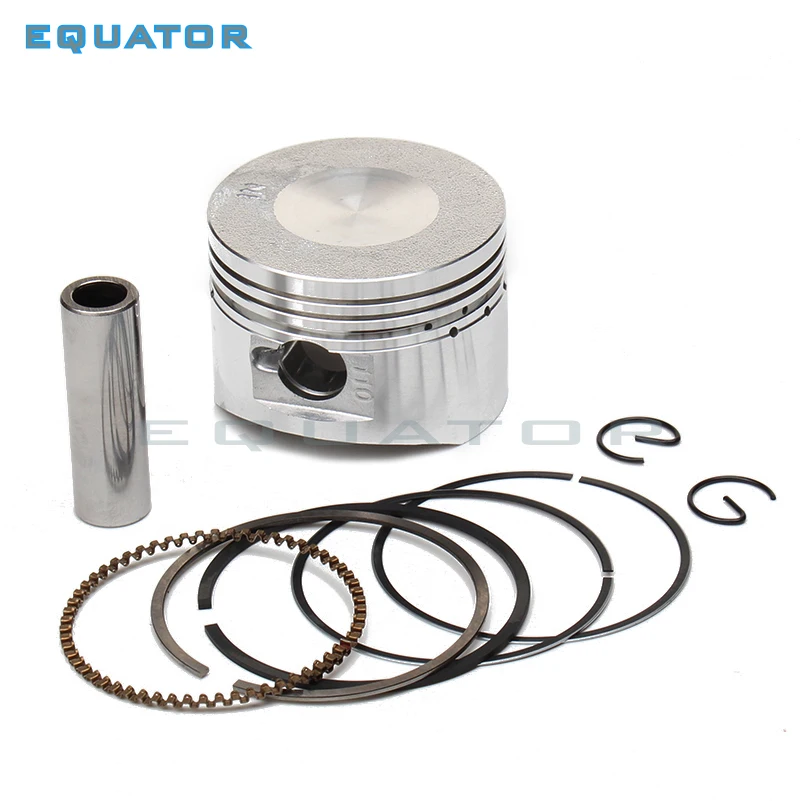
Time for a new piston kit? Find one here!
Step-by-step ProcessMeasure Ring End Gap
Before installing the rings onto the piston, it is imperative that the ring end gaps are checked and verified against the specs provided with the installation instructions or factory service manual, whichever is applicable. If more than one compression ring is used, confirm any design differences between the two by referencing the installation instructions. Chamfers on the inside edge of the ring or different markings at the ring ends are common identifiers used to denote ring differences. Need clarification on all the markings used on JE rings and pistons? Click here.
To check the ring end gap, simply install the appropriate ring into the cylinder bore and position it near the top of the bore.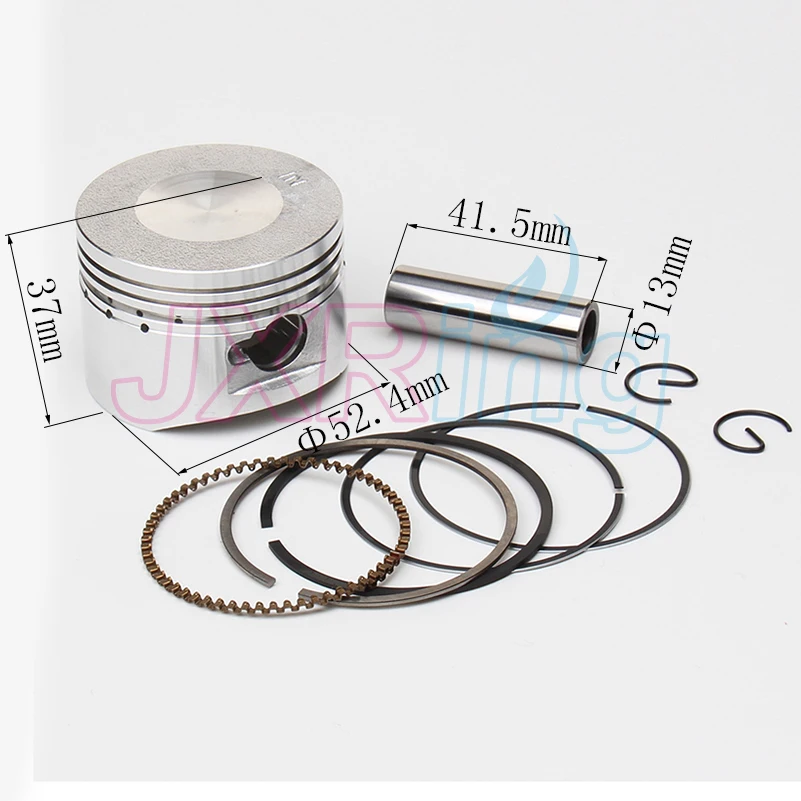 Use the depth rod end of a caliper to ensure the ring is square to the bore. Next, use feeler gauges to measure the ring’s end gap. Carefully insert various thickness feeler gauges between the ring ends until the gauge just begins to drag between the ring ends. Note the thickness of the gauge and compare it to the end gap specifications provided. This process can be repeated for any additional compression rings used.
Use the depth rod end of a caliper to ensure the ring is square to the bore. Next, use feeler gauges to measure the ring’s end gap. Carefully insert various thickness feeler gauges between the ring ends until the gauge just begins to drag between the ring ends. Note the thickness of the gauge and compare it to the end gap specifications provided. This process can be repeated for any additional compression rings used.
At JE Pistons, the ring end gaps are preset at the factory to fall within spec when installed in healthy cylinders used for normal applications. The end gap of the first compression ring should always be less than that of the second compression ring. If the end gap specs are outside of range, first double check your measurements and verify the cylinder bore is the correct diameter. Assuming no issues are found with the measurements or cylinder bore and the end gap measured is too tight, the rings can be carefully filed.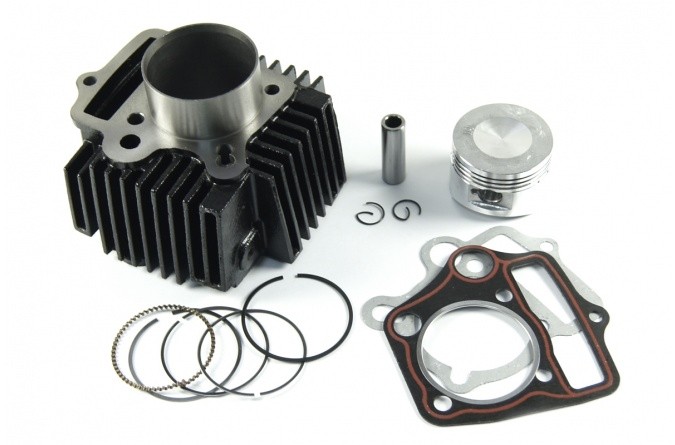 To do so, use a small file and file one end of the ring. Be sure to maintain parallelism to the other ring end as you remove material. Remove small amounts of material and check the end gap periodically so that you don’t remove too much material.
To do so, use a small file and file one end of the ring. Be sure to maintain parallelism to the other ring end as you remove material. Remove small amounts of material and check the end gap periodically so that you don’t remove too much material.
Clean
All piston rings should be cleaned before being assembled onto the piston. Before cleaning, confirm the ring ends are free of burrs. Any burrs present can carefully be dressed by gently breaking the edge with a small file. Next, use your preferred parts cleaner to wipe down the rings and piston.
Make sure your rings are clean and free of any debris or burrs.Mark the Piston
Review the instructions provided with your piston kit and note the specified positions of the ring end gaps. Use a marker to mark the edge of the piston crown with the intended ring end positions for the oil control and compression rings. Doing so will help ensure no orientation mistakes are made upon ring installation.
Doing so will help ensure no orientation mistakes are made upon ring installation.
Oil Control Ring Installation
Modern oil control rings typically utilize a three-piece design and consist of two side rails and an expander ring. Three-piece oil rings can be challenging to install if the ring design and methodology are not understood. The expander ring is the waffle shaped ring and features a stepped edge on the top and bottom of the ring. The side rails are the two small, thin rings which complement the expander. When properly installed, the side rails sit on the top and bottom of the expander ring against its stepped edges. For this reason, the expander ring must be installed first.
The other feature of the expander ring worth paying attention to is its ends. Due to the expander’s accordion-like shape, it is possible for the ring ends to overlap in the ring groove. For proper installation, it is imperative that the expander’s ends butt and do not overlap.
For proper installation, it is imperative that the expander’s ends butt and do not overlap.
To install the expander ring, lightly coat it with engine oil. The expander ring is non-directional, so it can be installed in any orientation. Carefully work the ring past the compression ring groove into the oil ring groove. Adjust the expander ring as necessary, so the ring ends are correctly positioned. Ensure the ring ends butt together and don’t overlap.
Start by installing the expander ring after lightly coating with oil.The side rails are also non-directional. Lightly lube the side rails then install them on the piston. Make sure the side rails sit correctly against the stepped edge of the expander ring and that their end gaps are positioned properly. Once the side rails have been installed, double-check the end gap positions of all three rings that comprise the oil control ring assembly. Ensure the expander ring’s ends are not overlapped and ensure the assembly moves freely within the oil ring groove.
Ensure the expander ring’s ends are not overlapped and ensure the assembly moves freely within the oil ring groove.
Compression Ring Installation
If the piston utilizes two compression rings, the second compression ring should be installed first. Refer to the installation instructions to determine the proper orientation of the ring before installation. Typically, dots or letters will be marked near the ring end, which denotes the top of the ring. Internal edge features such as chamfers may also be used to identify the ring and its correct orientation. Lightly oil the ring and then carefully work it over the piston into its appropriate groove. Adjust the ring’s end gap position so that it aligns with the mark you made for it on the piston crown. Repeat this process for any remaining compression rings.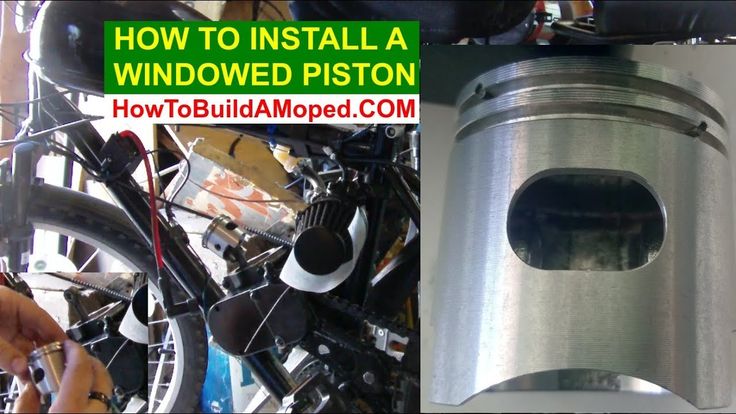
Confirm Groove Clearance
Once the compression rings have been installed, the ring-to-groove clearance should be checked. To do so, insert a feeler gauge between the ring and groove. The clearance can be identified by finding the feeler gauge that drags ever so slightly between the ring and groove. Note the groove clearance and compare it to the specification provided in the installation instructions or factory service manual.
One of the final measurements to take after the rings have been installed is compression ring to groove clearance. Use a feeler gauge for this and find the size that has slight drag. Compare this spec to what's outlined in your instructions or owner's manual.At this point, ring installation onto the piston is complete, and subsequent steps can be taken to complete the engine build.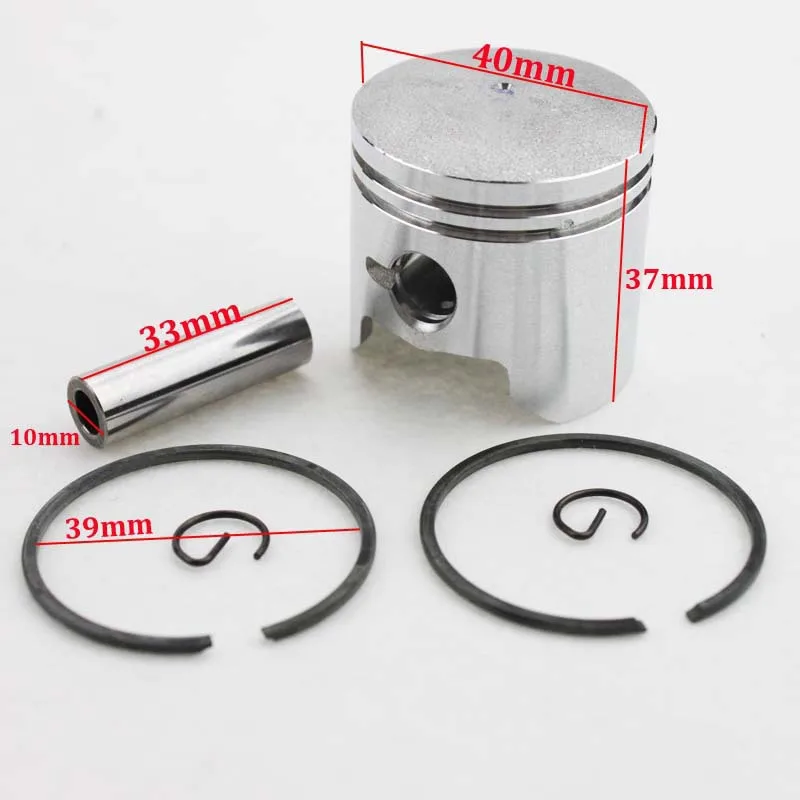 While installing the piston rings onto the piston is a critical step in the build process, it can be performed by anyone when the proper steps are taken. The process simply requires the correct measurements are taken, cleanliness is ensured, and installation techniques are used.
While installing the piston rings onto the piston is a critical step in the build process, it can be performed by anyone when the proper steps are taken. The process simply requires the correct measurements are taken, cleanliness is ensured, and installation techniques are used.
In search of a quality, performance forged piston for your bike or ATV? Click here to see what's available for your application.
COPYRIGHT © 2022 JEPISTONS ALL RIGHTS RESERVED. JE PISTONS IS PART OF THE RACE WINNING BRANDS FAMILY
Failure to ensure the correct ring gap can cause the ring tips to move and
engine damage can occur.
A torque plate must be attached to the engine block or cylinder (if applicable) and tightened with the same
torque as the bolts that should be used, according to the specifications, shall be torqued.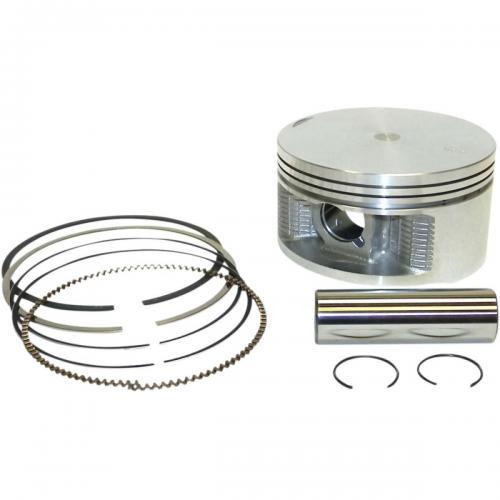
2. Check the ring gap by placing the ring in the cylinder. The cylinder bore must not be narrowed. Instead, use the piston to straighten the ring in the cylinder bore and check the end gap with a blade gauge.
3. See the table below for the correct ring gap for your engine.
4. The oil scraper rings do not need to be modified/sanded, but the gap should be
at least .010 ”.
1. This chart is in inches. If you measure in millimeters, you must do so by converting to inches. Then divide the measure by 25.4.
2. Multiply the bore in inches by the "Bore x" column to obtain the ring gap for your engine.
Example: For the upper ring of an ATV with a 4.0" bore, multiply 4.0 X 0.004 = 0.016"
1. The chart above is a general guideline. Each piston ring must be mounted in the specific
cylinder where they are to be installed and adjusted accordingly.
2.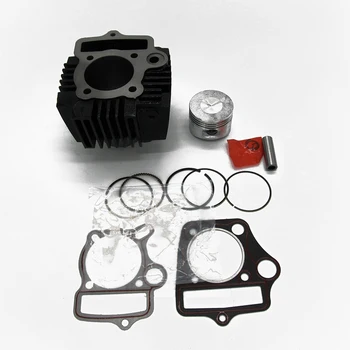 The gap on the second ring should always be larger than the upper ring gap. This
The gap on the second ring should always be larger than the upper ring gap. This
helps reduce top ring flutter.
1. The recommendation is to use a designated tool to file the piston rings. An electric ring sander or manual ring sander
2. Always file from outside the ring to avoid damage to the ring coating.
File only one end. Use the other end as a reference.
4. Be sure to keep the ring end square.
5. Sand only a little at a time until the desired ring gap is reached.
6. Remove all sharp edges and burrs. This is important to remove as burrs and sharp edges can cause engine failure.
Simple but essential information on how to install piston rings correctly. Study the pictures carefully and read the instructions below for a better understanding.
1. Check each ring's corresponding piston groove to ensure correct axial and radial play.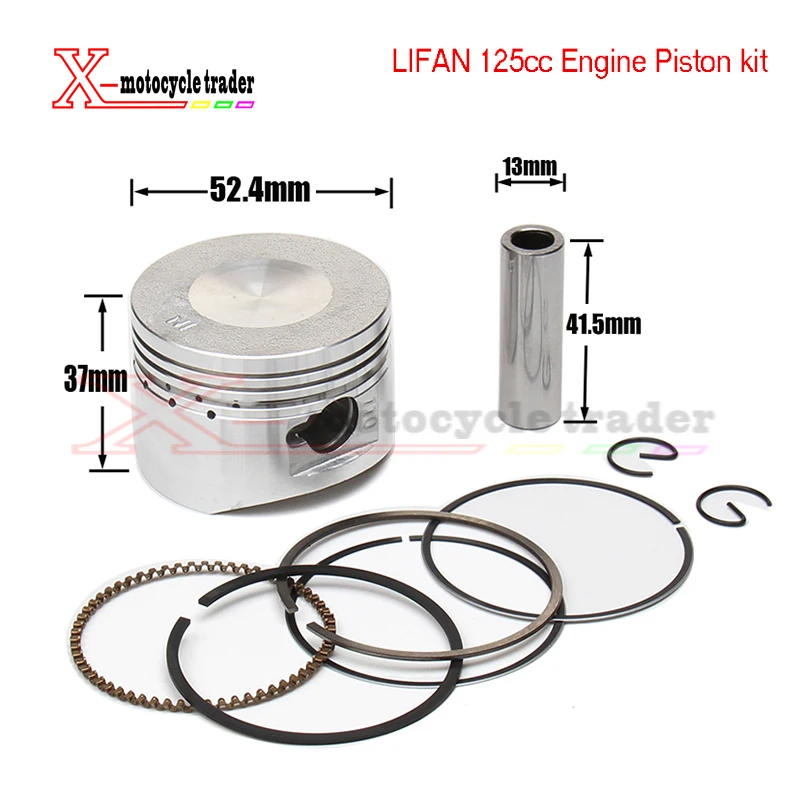
Axial clearance approx. 0.001"- 0.002"
Radial play must be at least 0.005"
Oil rings: Place the spring ring of the oil ring on each side of the oil ring in the lowest groove of the piston, with the ring ends 90° from each end of the piston bolt.
Make sure that the ends of the spring rings are visible and properly mounted. If the ends of the spring rings
overlaps, the engine will smoke due to this.
The oil ring can be installed with either side up. Install the ring in the piston ring groove between the expander ring/spring rings using a ring expander. The piston ring ends should be placed at least 90° from each other.
Once the oil ring has been installed, check that the scraper ring spring rings are
are mounted adequately as described above.
Second ring:
Install the second ring using a piston ring expander
The marked side should be up.
If you have an unmarked 2nd ring with an internal chamfer, the chamfer is installed downwards. If the ring is not marked in any way, it can be turned in both directions.
First ring:
Install the first ring using a piston ring expander.
The marked side should be up.
If you have an unmarked 1st ring with a chamfer, the chamfer is installed upwards (opposite ring number 2.). If the ring is not marked in any way, it can be in both directions.
Although the season for ATVs and motorcycles does not depend on the season and may not be interrupted, many motorists prefer snowmobiles in winter, sending ATVs and motorcycles to storage until the weather warms up.
Before long-term storage, it is not enough to simply clean the ATV of dirt and place it in a warm, dry garage. Its service life and the quality of further operation depend on the correct preparation of transport for wintering. Below are some recommendations for preparing equipment for long-term parking. nine0004
Below are some recommendations for preparing equipment for long-term parking. nine0004
Washing and cleaning the ATV and motorcycle before long-term parking
Before storing the motorcycle, thoroughly wash and then dry and cover all important components and mechanisms with preservation grease (you can use regular silicone grease in an aerosol can).
It is better to cover equipment for the winter, but not with polyethylene, but with a special protective cover made of breathable material. The cover will protect from dust and moisture, while not interfering with natural ventilation
Preparing the ATV and Motorcycle Fuel System for Long-term Parking
The ATV fuel system is susceptible to corrosion, so it is recommended to fill the fuel tank before "wintering" to allow the fuel to displace any remaining moisture on the inner walls. Over time, the fuel loses its properties, so it is recommended to replace the fuel with a new one at the beginning of the season before operation. If a plastic tank is installed on an ATV or motorcycle, then it is better to remove the fuel from it before parking. nine0004
If a plastic tank is installed on an ATV or motorcycle, then it is better to remove the fuel from it before parking. nine0004
Before conservation, in order to ensure safety, it is necessary to check the fuel system for possible damage and leakage
Preparing the engine of an ATV and a motorcycle for a long parking
the crankcase and parts such as pistons, cylinders, and piston rings, due to the lack of a protective oil film on them, can also be subject to corrosion. Therefore, before a long-term parking, it is recommended to unscrew the spark plugs and fill in engine oil through the candle wells, while manually turning the engine crankshaft several revolutions. The holes in the candle wells should be closed with rags or special plugs to prevent foreign objects from getting inside the ATV engine while the vehicle is parked. nine0004
This operation will help create a reliable oil film on the parts of the cylinder-piston group during parking and protect them from possible corrosion.
Remove excess oil from ATV or motorcycle cylinders before use. To do this, it will be enough to turn the crankshaft with the help of an electric starter or a kickstarter for 3-5 seconds with the carburetor throttle fully open.
Motorcycle and ATV fluid replacement
Before "wintering", it is recommended to replace all technical fluids (engine oil, antifreeze, brake fluid), if they are, of course, used in your vehicle.
Old engine oil may contain contaminants that will cause it to thicken and cause unwanted deposits on parts walls and in oil passages.
At the beginning of the season, the fluids will have to be changed again, because. over time, they oxidize and lose their properties.
Motorcycle and ATV battery storage
The battery can be stored without removing it from the ATV, but be sure to disconnect it from the on-board network. Environmental parameters are important storage conditions for batteries. The optimum temperature for battery storage is from -10 to + 10 degrees Celsius. The humidity in the room should be as low as possible, this will slow down the self-discharge process. The battery must be fully charged before storage. Storage of a discharged battery is unacceptable. During storage, it is necessary to control the charge level and, if necessary, recharge the battery
The optimum temperature for battery storage is from -10 to + 10 degrees Celsius. The humidity in the room should be as low as possible, this will slow down the self-discharge process. The battery must be fully charged before storage. Storage of a discharged battery is unacceptable. During storage, it is necessary to control the charge level and, if necessary, recharge the battery
Proper storage of ATV and motorcycle tires
Tires should not be exposed to freezing temperatures for extended periods of time. In the cold, rubber loses its properties and deteriorates. When storing in a garage, so that the wheels do not contact the frozen surface for a long time, it is better to install an ATV or a motorcycle on tackles. You should also monitor the tire pressure, it should not be too high or too low. nine0004
If you do not have a warm garage to store your ATV or motorcycle, you can use the services of individual storage. The transport will stay in a heated room for the required time, where the optimum temperature and humidity are maintained
| D | H | d | h | stroke | link |
| 36 | 30 | 10 | 11 | 4T | Piston Honda dio new AF61E |
| 37 | 29 | 10 | 12 | 4T | Piston SYM Mio, Jet4 50, Symphony, Allo - 37mm |
| 37.8 | 33 | 10 | 12 | 4T | Piston Honda dio af62 37. 8mm 8mm |
| 38 | 30 | 10 | 11 | 4T | Piston Honda dio af56-57 38mm |
| 39 | 31 | 10 | 12 | 4T | Piston Suzuki Lets 4, 5, address v50g - 4 stroke |
| 39 | 52 | 12 | 22 | 2T | Piston Honda DIO AF18 |
| 39 | 32 | 13 | 12 | 4T | Piston Honda Spacy 50, 39mm |
| 40 | 48 | 10 | 20 | 2T | Piston Honda Gyro X, Lead Delux |
| 40 | 48 | 10 | 20 | 2T | Piston Honda Tact AB07E 40mm, pin 10mm, Honda Tacty AB19, Honda Sky AB14 | nine0079
| 40 | 48 | 10 | 20. 5 5 | 2T | Piston Yamaha Jog, Next zone |
| 40 | 48 | 12 | 19 | 2T | Piston Honda Dio ZX (AF34/35) |
| 40 | 48 | 12 | 19 | nine0067 2TPiston Stels Leader, Skif | |
| 41 | 43 | 10 | 15 | 2T | Piston Honda Tact |
| 41 | 43 | 10 | 17 | 2T | Piston Suzuki Ran, Gemma, BM Mint |
| 41 | 42 | 10 | 14 | 2T | Piston Suzuki Sepia Address 50 |
| 41 | 48 | 10 | 21 | 2T | Piston Yamaha NF55 |
| 41 | 48 | 12 | 21 | 2T | Piston Suzuki A50, AC50, AS50, U50 |
| 41 | 37 | 13 | 13 | 4T | Piston Yamaha Virago XV-125 |
| 42 | 29 | 10 | 12 | 4T | Piston SYM Mio, Jet4 50, Symphony, Allo - 42mm |
42. 25 25 | 42 | 10 | nine0067 142T | Piston Suzuki Sepia Address 42.25mm | |
| 42.50 | 48 | 10 | 20.5 | 2T | Piston Yamaha Jog dia=42.5mm |
| 43 | 48 | 10 | 20.5 | 2T | Piston Yamaha Jog dia=43mm | nine0079
| 43 | 42 | 10 | 14 | 2T | Piston Suzuki Sepia Address 43mm |
| 43 | 43 | 10 | 17 | 2T | Piston Suzuki Ran, chain 43mm |
| 43 | 48 | 10 | 20.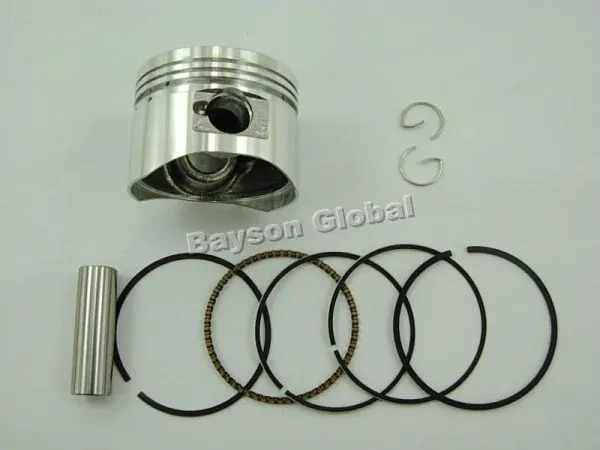 5 5 | nine0067 2T Piston JS60 43mm | |
| 43 | 51.5 | 12 | 22 | 2T | Piston Honda dio 65cc Honda dio af-18/27, 43mm |
| 44 | 42 | 10 | 14 | 2T | Piston Suzuki Sepia Address 44mm |
| 44 | 48 | 12 | 19 | 2T | Piston Stels Leader, Skif, Arrow, Tactic - 44 mm |
| 44 | 51.5 | 12 | 22 | 2T | Piston Honda dio 65cc Honda dio af-18/27, 44mm |
| 44 | 47 | 10 | 20 | 2T | Piston Yamaha CT-70 |
| 44 | 44 | 13 | 14 | 4T | Piston Jh225T |
| 44 | 32 | 13 | 13 | 4T | Piston 62cc - 44mm Chinese 4-stroke |
| D | nine0067 Hd | h | stroke | link | |
| 44 | 48 | 12 | 20 | 2T | Piston Honda Dio ZX65 af34/35 44mm |
| 47 | 57 | 12 | 23 | 2T | Piston Yamaha CY-80 |
| 47 | 40 | 13 | 11 | 4T | Piston 72cc - 47mm Chinese 4-stroke 139FMB |
| 47 | 34 | 13 | 11 | 4T | Piston 72cc - 47mm Chinese 4-stroke 139QMB |
| 47 | 56 | nine0067 12 19.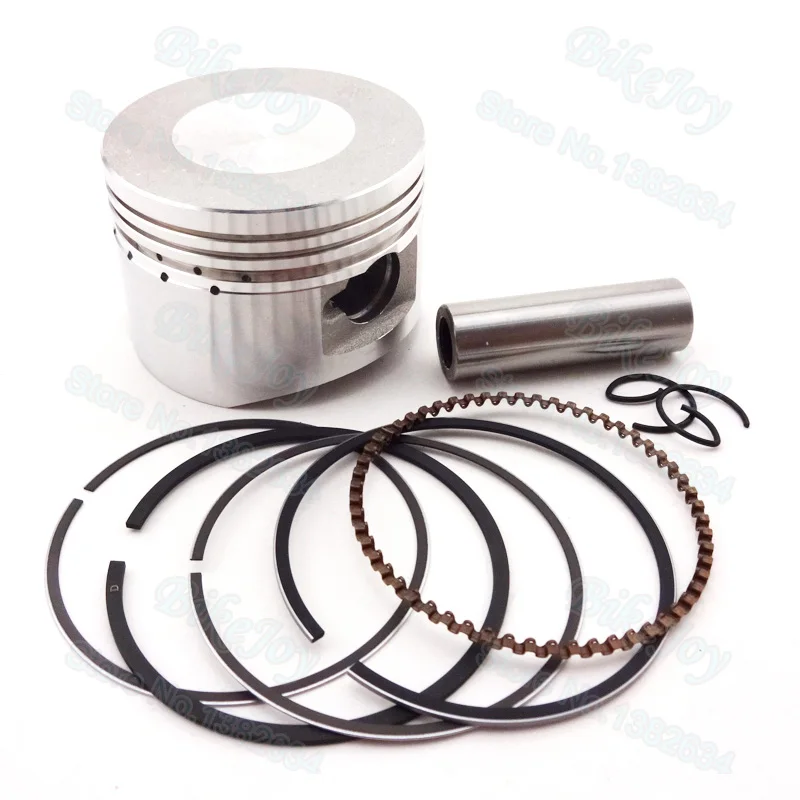 5 5 | 2T | Piston Suzuki A80 | |
| 47 | 48 | 10 | 21 | 2T | Piston Yamaha Jog tuning 70cc - 47mm, pin 10mm |
| 47 | 48 | 12 | 20 | 2T | Piston Stels tuning 70cc - 47mm, pin 12mm |
| 47 | 51.5 | 12 | 22.5 | 2T | Piston Honda dio af18 47mm |
| 48 | 51.5 | 12 | 22. 5 5 | 2T | Piston Honda dio af18 48mm |
| 48 | 48 | 12 | nine0067 192T | Piston Honda dio af34 48mm | |
| 48 | 54 | 12 | 20 | 2T | Piston Honda Lead 90 |
| 48 | 41 | 14 | 13 | 4T | Piston Yamaha FZR (250cc) |
| 48 | 48 | 10 | 21 | 2T | Piston Yamaha Jog tuning 75cc - 48mm, pin 10mm |
| 49 | 57 | 12 | 22 | 2T | Piston Yamaha Champ 80 |
| 49 | 40 | 13 | 13 | 4T | Piston Yamaha Virago 250 XV250 |
| 49 | 40 | 13 | 13 | 4T | Piston Yamaha YFA Breeze 125 |
| 50 | 60 | 14 | 21. 5 5 | 2T | Piston Suzuki AX100 |
| 50 | 56 | 14 | 19 | 2T | Piston Suzuki K90, 50mm |
| 50 | 60 | 12 | 27 | 2T | Piston Yamaha Axis 90 |
| 50 | 44 | 13 | 14 | 4T | Piston Honda WIN100 | nine0079
| 50 | 42 | 13 | 13 | 4T | Piston Honda Spacy 100 - Ch200 |
| 50 | 37 | 15 | 13 | 4T | Piston 100cc 50mm 4-stroke. Chinese finger 15mm!!! Chinese finger 15mm!!! |
| 50 | 53 | 12 | nine0067 202T | Piston ATV ADLY 100 | |
| 50 | 34 | 13 | 10.5 | 4T | Piston 139QMB 82cc - 50mm |
| 51 | 34 | 13 | 10.5 | 4T | 139QMB 90cc - 51mm Kiyoshi Taiwan |
| 51 | 62.5 | 13 | 24 | 2T | Piston Honda Lead 100 |
| 52 | 57 | 12 | 26. 5 5 | 2T | Piston Stels Tactic 100 CMR Taiwan |
| 52 | 61 | 12 | 28 | nine0067 2TPiston Stels tactic 100 | |
| 52 | 57 | 12 | 26.5 | 2T | Piston Yamaha Axis 100 CMR Taiwan |
| 52 | 61 | 12 | 28 | 2T | Piston Yamaha Axis 100 |
| 52 | nine0067 6014 | 26 | 2T | Piston Yamaha BWS 100, pin 14mm | |
| D | H | d | h | stroke | link |
| 52 | 56 | 14 | 19 | 2T | Piston Suzuki K100 | nine0079
| 52 | 38 | 14 | 12.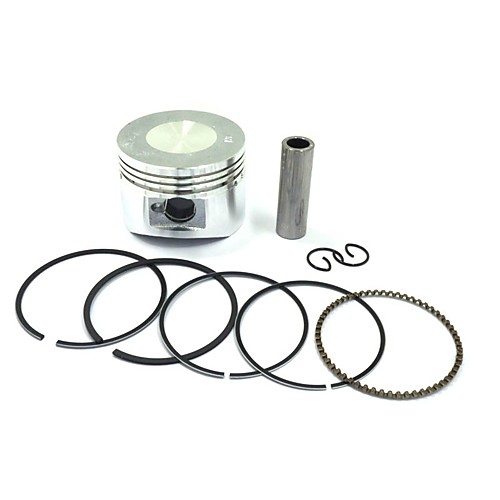 5 5 | 4T | Piston Suzuki Vecstar 125 (AN125) |
| 52.4 | 37 | 13 | 12.5 | 4T | Piston TTR125, Kayo Basic 153FMI 154FMI |
| 52.4 | 37 | 13 | nine0067 12.54T | Piston Alpha, Delta, 110cc | |
| 52.4 | 38 | 15 | 12 | 4T | Piston Honda Spacy 125cc (Ch225) |
| 52.4 | 37 | 15 | 12.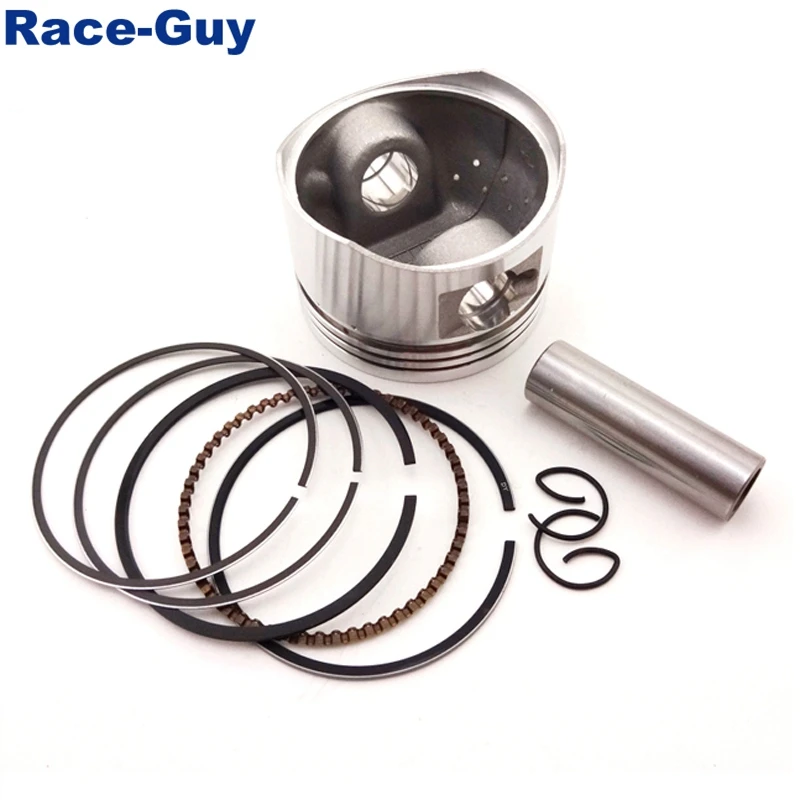 5 5 | 4T | Piston 125cc - 52.4mm Chinese 4-stroke |
| 52.4 | 35 | 15 | 12.5 | 4T | Piston Yamaha Cygnus X 125 |
| 52.5 | 57 | 12 | 22 | 2T | Piston Suzuki Address 100 |
| 52.5 | 57 | 14 | 21 | 2T | Piston Suzuki Address 110 |
| 53 | 45 | 13 | 13.5 | 4T | Piston 53mm AN90 4 stroke |
| 55 | 64 | 15 | 27 | 2T | Piston Kawasaki GTO-125 |
| 55 | nine0067 6213 | 22 | 2T | Piston Lead 100 JF06 enlarged 55mm Taiwan Kiyoshi | |
| 56 | 41.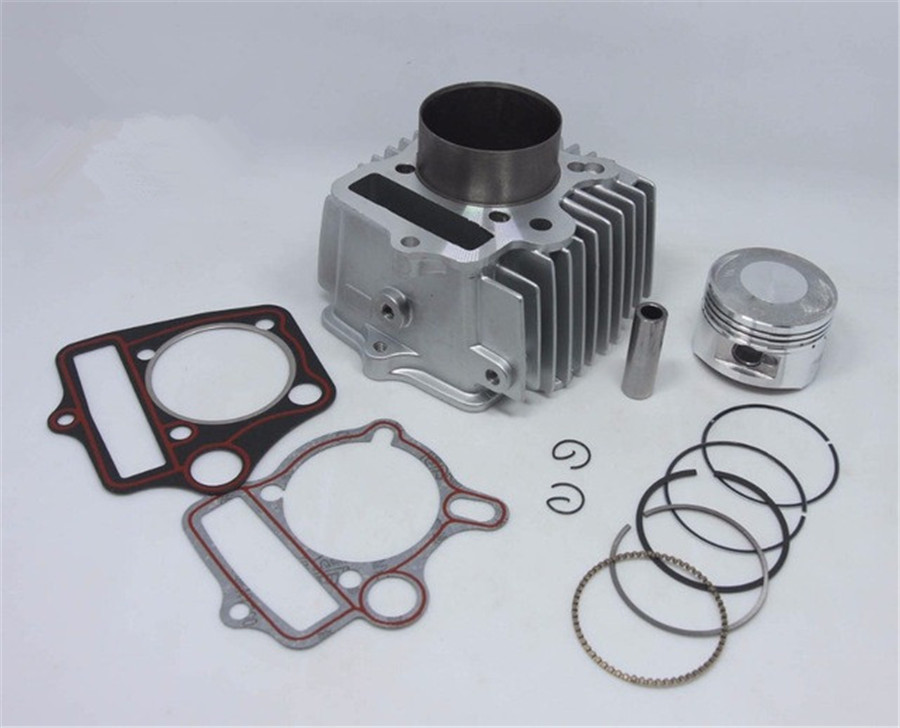 5 5 | 13 | 13 | 4T | Piston KAYO 140 |
| 56 | 70 | 16 | 32 | 2T | nine0067 Piston Yamaha RX125, 2-stroke|
| 56.5 | 52 | 15 | 14 | 4T | Piston JH-125 4-stroke |
| 56.5 | 52 | 15 | 16 | 4T | Piston CG/CB-125, 56.5mm |
| 57 | 38 | nine0067 1512 | 4T | Piston Honda Spacy 150cc Ch250 | |
| 57 | 38 | 15 | 12 | 4T | Piston Suzuki Vecstar 150 (AN150) |
57. 4 4 | 38 | 15 | 13 | 4T | Piston 150cc 4-stroke with 157QMJ 9 engine0068 |
| 58 | 66 | 16 | 28 | 2T | Piston Yamaha RX135 |
| 61 | 38 | 15 | 12.5 | 4T | Piston 152QMI, 157QMJ, 161QMK 170cc - 61mm |
| 61 | 53 | 15 | nine0067 174T | Piston JH-145 4-stroke | |
| 62 | 53 | 15 | 16.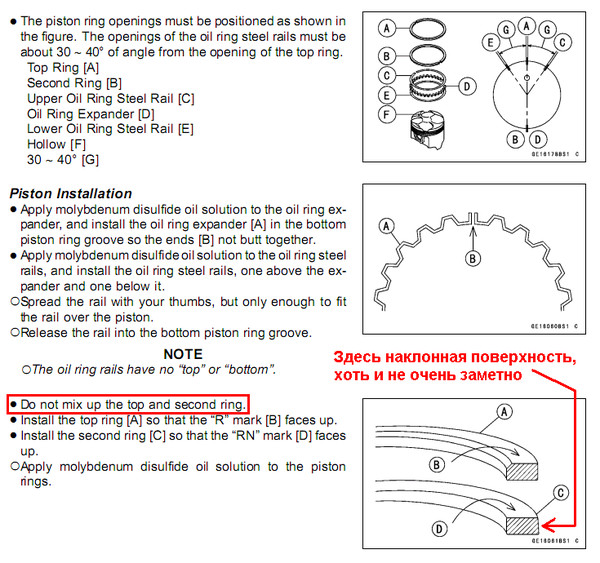 5 5 | 4T | Piston CG-150 (162FMJ), 62mm, pin 15mm |
| 63.5 | 46 | 15 | 15 | 4T | Piston CG-200 (163FML), 63.5mm, pin 15mm |
| 65.5 | 42 | 15 | 14.5 | 4T | Piston CB-250 (165FMM), 65.5mm, pin 15mm |
| 67 | 46 | 16 | 16 | 4T | Piston CB/CG 200-250, 167FML, 167FMM |
| 69 | 49 | 17 | 16 | 4T | Piston CB-230 (169FMM), 69mm, pin 17mm |
| 72 | 47 | 17 | 14 | 4T | Piston Honda Spacy 250 |
| nine0067 | |||||
motochasti. | |||||